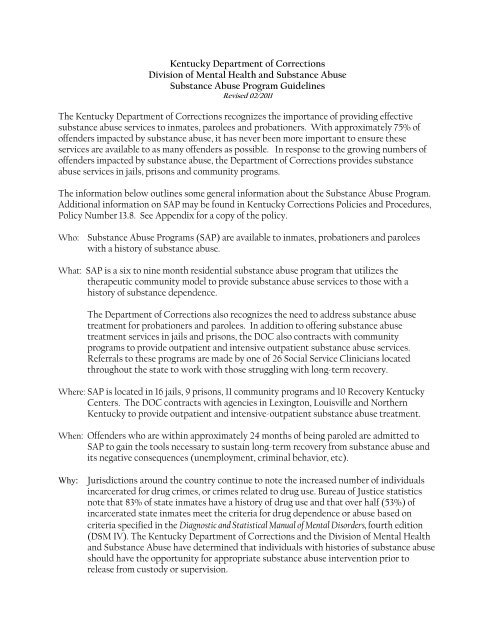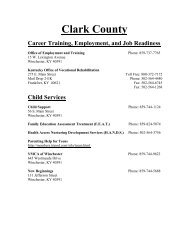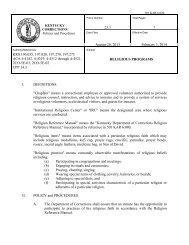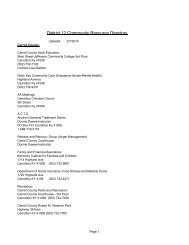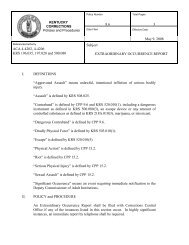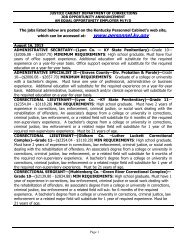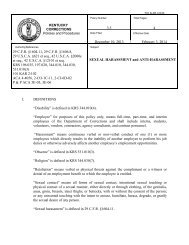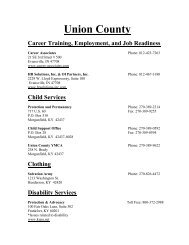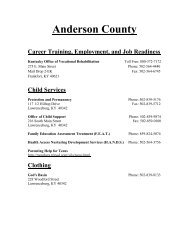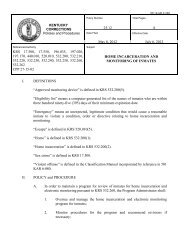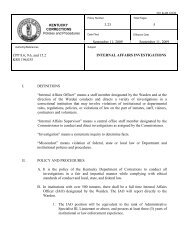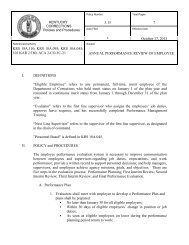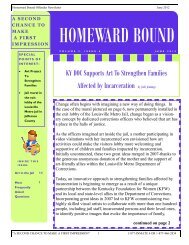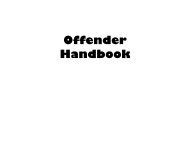Kentucky Department of Corrections Division of Mental Health and ...
Kentucky Department of Corrections Division of Mental Health and ...
Kentucky Department of Corrections Division of Mental Health and ...
Create successful ePaper yourself
Turn your PDF publications into a flip-book with our unique Google optimized e-Paper software.
<strong>Kentucky</strong> <strong>Department</strong> <strong>of</strong> <strong>Corrections</strong><strong>Division</strong> <strong>of</strong> <strong>Mental</strong> <strong>Health</strong> <strong>and</strong> Substance AbuseSubstance Abuse Program GuidelinesRevised 02/2011The <strong>Kentucky</strong> <strong>Department</strong> <strong>of</strong> <strong>Corrections</strong> recognizes the importance <strong>of</strong> providing effectivesubstance abuse services to inmates, parolees <strong>and</strong> probationers. With approximately 75% <strong>of</strong><strong>of</strong>fenders impacted by substance abuse, it has never been more important to ensure theseservices are available to as many <strong>of</strong>fenders as possible. In response to the growing numbers <strong>of</strong><strong>of</strong>fenders impacted by substance abuse, the <strong>Department</strong> <strong>of</strong> <strong>Corrections</strong> provides substanceabuse services in jails, prisons <strong>and</strong> community programs.The information below outlines some general information about the Substance Abuse Program.Additional information on SAP may be found in <strong>Kentucky</strong> <strong>Corrections</strong> Policies <strong>and</strong> Procedures,Policy Number 13.8. See Appendix for a copy <strong>of</strong> the policy.Who:Substance Abuse Programs (SAP) are available to inmates, probationers <strong>and</strong> paroleeswith a history <strong>of</strong> substance abuse.What: SAP is a six to nine month residential substance abuse program that utilizes thetherapeutic community model to provide substance abuse services to those with ahistory <strong>of</strong> substance dependence.The <strong>Department</strong> <strong>of</strong> <strong>Corrections</strong> also recognizes the need to address substance abusetreatment for probationers <strong>and</strong> parolees. In addition to <strong>of</strong>fering substance abusetreatment services in jails <strong>and</strong> prisons, the DOC also contracts with communityprograms to provide outpatient <strong>and</strong> intensive outpatient substance abuse services.Referrals to these programs are made by one <strong>of</strong> 26 Social Service Clinicians locatedthroughout the state to work with those struggling with long-term recovery.Where: SAP is located in 16 jails, 9 prisons, 11 community programs <strong>and</strong> 10 Recovery <strong>Kentucky</strong>Centers. The DOC contracts with agencies in Lexington, Louisville <strong>and</strong> Northern<strong>Kentucky</strong> to provide outpatient <strong>and</strong> intensive-outpatient substance abuse treatment.When: Offenders who are within approximately 24 months <strong>of</strong> being paroled are admitted toSAP to gain the tools necessary to sustain long-term recovery from substance abuse <strong>and</strong>its negative consequences (unemployment, criminal behavior, etc).Why: Jurisdictions around the country continue to note the increased number <strong>of</strong> individualsincarcerated for drug crimes, or crimes related to drug use. Bureau <strong>of</strong> Justice statisticsnote that 83% <strong>of</strong> state inmates have a history <strong>of</strong> drug use <strong>and</strong> that over half (53%) <strong>of</strong>incarcerated state inmates meet the criteria for drug dependence or abuse based oncriteria specified in the Diagnostic <strong>and</strong> Statistical Manual <strong>of</strong> <strong>Mental</strong> Disorders, fourth edition(DSM IV). The <strong>Kentucky</strong> <strong>Department</strong> <strong>of</strong> <strong>Corrections</strong> <strong>and</strong> the <strong>Division</strong> <strong>of</strong> <strong>Mental</strong> <strong>Health</strong><strong>and</strong> Substance Abuse have determined that individuals with histories <strong>of</strong> substance abuseshould have the opportunity for appropriate substance abuse intervention prior torelease from custody or supervision.
Institutional Programs (9)Green RiverCentral City, KY<strong>Kentucky</strong> Correctional Institution for WomenPewee Valley, KYPhoenix (KSR)*Lagrange, KYLuther LuckettLagrange, KYMarion Adjustment CenterSt. Mary, KYOtter CreekWheelwright, KYRoederer Correctional ComplexLagrange, KYWestern <strong>Kentucky</strong> Correctional ComplexFredonia, KYChallenges (KCIW)*Pewee Valley, KY*The Phoenix Program at KSR <strong>and</strong> the Challenges Program at KCIW are co-occurring treatmentprograms designed to address substance abuse <strong>and</strong> mental health treatment needs.Community Programs (11)Chrysalis HouseLexington, KYCTS RussellLouisville, KYDismas Owensboro for MenOwensboro, KYDismas Owensboro for WomenOwensboro, KYHealing Place for WomenLouisville, KYHope Center for WomenLexington, KYPrivett CenterLexington, KYRenaissance HouseLouisville, KYSt. Ann’sLouisville, KYWestcareAshcamp. KYVolunteers <strong>of</strong> AmericaLouisville, KY3
Recovery <strong>Kentucky</strong> Centers (10)Probationers <strong>and</strong> Parolees OnlyBrighton Recovery CenterFlorence, KYCumberl<strong>and</strong> HopeEvarts, KYLiberty PlaceRichmond, KYTrilogy CenterHopkinsville, KYWomen’s Addiction Recovery Manor(WARM)Henderson, KYAlternative Recovery CenterCampbellsville, KYGrateful Life CenterErlanger, KYMorehead Inspiration CenterMorehead, KYOwensboro Regional RecoveryOwensboro, KYCenter PointPaducah, KYThe Substance Abuse Program (SAP) Application• The first step in the process <strong>of</strong> being admitted to SAP is to complete the SAP Application• Any inmate may apply for admission to SAP• An application can be obtained from the Class D Coordinator in any jail or from a CTOat any prison.• A copy <strong>of</strong> the SAP application can be found in the Appendix.The SAP Application Process• After the application is completed, it is mailed to the address on the bottom <strong>of</strong> theapplication.• The application is reviewed by Substance Abuse Program Administrators to determineappropriateness for the program.• Once approved, the inmate receives a letter alerting him that he has been approved <strong>and</strong>has been placed on the SAP Waiting List.• If an inmate has Parole Upon Completion status, he is given priority status over those onthe waiting list who are not Parole Upon Completion.4
• Every parole upon completion <strong>of</strong>fender on the SAP Waiting List is reviewed by aSubstance Abuse Program Administrator for his eligibility to complete SAP in acommunity program or a Recovery <strong>Kentucky</strong> Center.• The names <strong>of</strong> <strong>of</strong>fenders that meet the criteria to complete SAP in a community programare submitted to the Parole Board in order for the board to amend the <strong>of</strong>fender’s parolestipulations.• When a vacancy becomes available, the <strong>of</strong>fender is transferred to the facility where hewill complete SAP.• If an inmate is transferred or admitted to a Substance Abuse Program without goingthrough the above procedure, the jail will not be reimbursed for the SAP servicesprovided.• A jail may not enroll inmates in SAP at its own discretion. The Substance AbuseProgram Administrators must approve <strong>and</strong> initiate all jail SAP admissions.• Jails that refuse to transport an inmate from a jail to attend SAP will not receiveadditional referrals until the inmate has been transported.• A jail may not refuse to transport a SAP referral due to medical costs associated with theinmate. If an inmate has been approved for SAP <strong>and</strong> referred to a specific program, thejail who received the referral must transport the inmate. Any exceptions to this rulemust be approved by the Director <strong>of</strong> Local Facilities <strong>and</strong> the Director <strong>of</strong> the <strong>Division</strong> <strong>of</strong><strong>Mental</strong> <strong>Health</strong> <strong>and</strong> Substance Abuse.The Waiting List• The SAP Waiting List is maintained by <strong>Division</strong> <strong>of</strong> <strong>Mental</strong> <strong>Health</strong> <strong>and</strong> Substance Abusestaff• The assigned staff person works closely with Classification to ensure that inmates aretransferred to the appropriate facility in a timely manner.• An <strong>of</strong>fender is added to the waiting list after his application has been reviewed by aSubstance Abuse Program Administrator• If an <strong>of</strong>fender is added to the waiting list <strong>and</strong> later decides to refuse SAP services, hemust complete a SAP Refusal Form in order to be removed from the waiting list.• When an <strong>of</strong>fender is admitted to a program, his status is updated in KOMS by theSubstance Abuse Program Administrator from “Waiting List” to “Active Participant”• This change in status will remove the <strong>of</strong>fender from the waiting list.• The waiting list changes daily as <strong>of</strong>fenders are added to or removed from it.Refusals• Any inmate that refuses SAP after being recommended by the Parole Board or<strong>Department</strong> <strong>of</strong> <strong>Corrections</strong> personnel to complete it must sign a SAP Refusal Form.• <strong>Department</strong> <strong>of</strong> <strong>Corrections</strong> staff receiving the refusal must update the <strong>of</strong>fender’s status inKOMS to reflect the refusal.5
The Daily Roster• All Jail Substance Abuse Programs are required to submit a daily roster that includes thename <strong>of</strong> each person in SAP to the Substance Abuse Program Administrators• Rosters must also include the name <strong>of</strong> any mentors in the program.• A copy <strong>of</strong> a sample roster is included in the Appendix.Jail Transports• Jail Substance Abuse Programs are required to transport SAP referrals to its facilityregardless <strong>of</strong> the referrals location.• Jail Substance Abuse Programs have one week to transport a SAP referral.• If an inmate refuses SAP after being transported from a jail or prison to complete SAP, heor she may face disciplinary action <strong>and</strong> may be required to pay restitution to cover thetransportation costs incurred.Medical Issues• Once an inmate has been approved for SAP, he must be admitted to a program. Aninmate may not be refused admission due to medical costs associated with the inmatewithout the permission <strong>of</strong> the Director <strong>of</strong> Local Facilities <strong>and</strong> the Director <strong>of</strong> <strong>Mental</strong>Heath <strong>and</strong> Substance Abuse.Religious Issues• SAP inmates must be afforded an opportunity to participate in religious services <strong>and</strong>receive religious counseling within the facility or institution.• SAP inmates are not required to attend or participate in any religious service ordiscussion.Alcohol <strong>and</strong> Other Drug Entity (AODE) Licensure• The <strong>Department</strong> <strong>of</strong> <strong>Corrections</strong> is working with all jail <strong>and</strong> prison Substance AbusePrograms to obtain an Alcohol <strong>and</strong> Other Drug Entity (AODE) licensure. Many<strong>of</strong>fenders in SAP have received DUI charges <strong>and</strong> must complete a licensed treatmentprogram in order to regain driving privileges. DUI state regulations require thatsubstance abuse program be a licensed AODE for the court to recognize the substanceabuse treatment received.• All jail <strong>and</strong> prison Substance Abuse Programs must work with the Substance AbuseProgram Administrators toward receiving AODE licensure.7
The Therapeutic Community ModelThe <strong>Department</strong> <strong>of</strong> <strong>Corrections</strong> Substance Abuse Programs located in jails, institutions <strong>and</strong>many community programs follow the Therapeutic Community model to effectively treat the<strong>of</strong>fender population. The therapeutic community (TC) for the treatment <strong>of</strong> drug abuse <strong>and</strong>addiction has existed for about 40 years. In general, TCs are drug-free residential settings thatuse a hierarchical model with treatment stages that reflect increased levels <strong>of</strong> personal <strong>and</strong> socialresponsibility. Peer influence, mediated through a variety <strong>of</strong> group processes, is used to helpindividuals learn <strong>and</strong> assimilate social norms <strong>and</strong> develop more effective social skills.Therapeutic Communities differ from other treatment approaches principally in their use <strong>of</strong> thecommunity, comprising treatment staff <strong>and</strong> those in recovery, as key agents <strong>of</strong> change. Thisapproach is <strong>of</strong>ten referred to as "community as method." TC members interact in structured <strong>and</strong>unstructured ways to influence attitudes, perceptions, <strong>and</strong> behaviors associated with drug use.Therapeutic Communities operate separately from other programs <strong>and</strong> are located away fromthe general population. As a participant in the community, the <strong>of</strong>fender is expected to adhere tostrict <strong>and</strong> explicit behavioral norms. These norms are reinforced with specific contingencies(rewards <strong>and</strong> punishments) directed toward developing self-control <strong>and</strong> responsibility. Theresident will progress through a hierarchy <strong>of</strong> increasingly important roles, with greaterprivileges <strong>and</strong> responsibilities. Other aspects <strong>of</strong> the TCs "community as method" therapeuticapproach focus on changing negative patterns <strong>of</strong> thinking <strong>and</strong> behavior through individual <strong>and</strong>group therapy, group sessions with peers, community-based learning, confrontation, games, <strong>and</strong>role-playing.TC members are expected to become role models who actively reflect the values <strong>and</strong> teachings <strong>of</strong>the community. Ordered routine activities are intended to counter the characteristicallydisordered lives <strong>of</strong> the <strong>of</strong>fenders <strong>and</strong> teach them how to plan, set, <strong>and</strong> achieve goals <strong>and</strong> beaccountable.Ultimately, participation in a TC is designed to help people appropriately <strong>and</strong> constructivelyidentify, express, <strong>and</strong> manage their feelings. The concepts <strong>of</strong> "right living" (learning personal <strong>and</strong>social responsibility <strong>and</strong> ethics) <strong>and</strong> "acting as if" (behaving as the person should be rather thanhas been) are integrated into the TC groups, meetings, <strong>and</strong> seminars. These activities areintended to heighten awareness <strong>of</strong> specific attitudes or behaviors <strong>and</strong> their impact on oneself<strong>and</strong> the social environment (National Institute on Drug Abuse Research Report Series:Therapeutic Communities, 2002).Substance Abuse Programs at the institutions are staffed by <strong>Department</strong> <strong>of</strong> <strong>Corrections</strong>personnel. At the jails, staffing for Substance Abuse Programs is the jailers’ responsibility. Eachjailer is aware <strong>of</strong> the 20:1 inmate to staff ratio that is outlined in the jail’s contract with the<strong>Department</strong> <strong>of</strong> <strong>Corrections</strong>. Both jail <strong>and</strong> prison programs have a program director that worksclosely with DOC Substance Abuse Program Administrators to ensure effective operation <strong>of</strong> theprogram. Substance Abuse Program Administrators must be a part <strong>of</strong> the hiring on SubstanceAbuse Program staff at the jails <strong>and</strong> institutions.8
The Need for MentorsThe socialization history <strong>of</strong> serious substance abusers is marked by negative peer influence.Because <strong>of</strong> this, residents <strong>of</strong> the therapeutic community are also susceptible to negative peerinfluences, <strong>and</strong> most trace their initiation into drug use to peers. Typically, other drug userswere their main peer relationships during their years <strong>of</strong> active drug use.Generally, the criminal history <strong>of</strong> substance abusers is also related to peer influences. For mostresidents, their illegal activities began with regular drug use, usually in conjunction with peers.With continued abuse or addiction, these criminal patterns <strong>of</strong>ten escalated to more severecrimes.In the therapeutic community perspective a positive mentor culture must be maintained inorder to counter the negative peer influence. New residents are directed toward positivethinking, conduct <strong>and</strong> values by peers who-though similar to their associates in the past-aredifferent in the present. For this reason, it is vital, <strong>and</strong> necessary, to create <strong>and</strong> maintain apositive mentor culture within the therapeutic community. Individuals who have exhibitedpositive behaviors <strong>and</strong> attitudes are selected to assist in these roles. These are most <strong>of</strong>ten men orwomen in the late stages <strong>of</strong> treatment. In the role <strong>of</strong> community managers, these mentors displayaccountability to each other <strong>and</strong> to the community. These mentors serve as role models <strong>and</strong> areexpected to display the behavior, attitudes <strong>and</strong> expectations for the community. The strength <strong>of</strong>the community as a tool for social learning corresponds to the number <strong>and</strong> quality <strong>of</strong> its rolemodels. For these reasons, the mentor position is vital to the strength <strong>of</strong> the overall program(De Leon, Therapeutic Community, Theory, Model <strong>and</strong> Method).Each Substance Abuse Program must have a minimum <strong>of</strong> two mentors. Programs with morethan 40 inmates must increase its number <strong>of</strong> mentors to reflect a 20:1 ratio.Substance Abuse Program CurriculumThe curricula used by the jail, prison <strong>and</strong> Recovery <strong>Kentucky</strong> Centers <strong>and</strong> the communitysubstance abuse programs must include the Twelve Steps (Alcoholics Anonymous/NarcoticsAnonymous), Relapse Prevention <strong>and</strong> Cognitive Behavioral Therapy.Cognitive Behavioral Therapy (CBT) is based on the idea that a persons distorted thoughts <strong>and</strong>beliefs lead to his or her negative moods <strong>and</strong> unhealthy behaviors. Cognitive behavioral therapyholds the person accountable for you feelings <strong>and</strong> behaviors-not other people. For those involvedin the legal system, CBT provides an additional opportunity to intervene with <strong>of</strong>fenders by als<strong>of</strong>ocusing on developing skills for living in harmony with the community <strong>and</strong> engaging inbehaviors that contribute to positive outcomes in society (Cognitive-Behavioral Treatment, U.S.<strong>Department</strong> <strong>of</strong> Justice, National Institute <strong>of</strong> <strong>Corrections</strong>, May, 2007).Relapse Prevention focuses on identifying specific high-risk situations for each <strong>of</strong>fender <strong>and</strong>enhancing his or her skills for coping with those situations <strong>and</strong> restructuring the client’sperceptions <strong>of</strong> the relapse process (Relapse Prevention, An Overview <strong>of</strong> Marlatt’s Cognitive-Behavioral Model, Larimer, Palmer <strong>and</strong> Marlatt, 1999).9
The Community ProgramsIn addition to the jail <strong>and</strong> prison programs outlined above, the <strong>Department</strong> <strong>of</strong> <strong>Corrections</strong> alsopartners with a number <strong>of</strong> community agencies to provide needed substance abuse services.These community programs provide outpatient, intensive outpatient <strong>and</strong> residentialinterventions to probationers <strong>and</strong> parolees who are struggling with recovery from drugs <strong>and</strong>alcohol. The <strong>Department</strong> currently contracts with local treatment agencies to provide intensiveoutpatient services for 378 clients in the major metropolitan areas.The Social Service Clinicians (SSC)There are 26 Social Service Clinicians located throughout <strong>Kentucky</strong> to provide substance abuseassessments, case management <strong>and</strong> referrals to probationers <strong>and</strong> parolees in need <strong>of</strong> communitysubstance abuse services. These clinicians are located in Probation <strong>and</strong> Parole <strong>of</strong>fices <strong>and</strong> serveas liaisons for <strong>of</strong>fenders <strong>and</strong> community agencies They are based in each <strong>of</strong> the 19 Probation <strong>and</strong>Parole districts, <strong>and</strong> many cover the 2-5 <strong>of</strong>fices located in their district (covering sometimes asmany as 6-12 counties). Parolees being released are regularly stipulated by the parole board toreceive substance abuse assessments by a Social Service Clinician. Parole <strong>of</strong>ficers will refer<strong>of</strong>fenders on probation <strong>and</strong> parole that appear to have a history <strong>of</strong> substance abuse or receive asubstance related arrest/conviction to them. Circuit court judges order <strong>of</strong>fenders to undergo asubstance abuse assessment by an SSC as a condition <strong>of</strong> their probation supervision. Often theSSC will provide numerous interventions with an <strong>of</strong>fender during their time on supervision.They make treatment recommendations <strong>and</strong> act as liaison with the treatment provider while the<strong>of</strong>fender is being treated. If the <strong>of</strong>fender is unsuccessful, the SSC may make a referral for a higherlevel <strong>of</strong> care. The Social Service Clinicians specialize in substance abuse treatment services, but<strong>of</strong>ten are asked to see <strong>of</strong>fenders with mental health issues to assist the Probation <strong>and</strong> Parole<strong>of</strong>ficers. In areas where substance abuse resources are limited, Social Service Clinicians provideindividual <strong>and</strong> group services. The work <strong>of</strong> these clinicians is crucial in the successful re-entry<strong>of</strong> <strong>of</strong>fenders back in to the community. Social Service Clinicians <strong>and</strong> Probation <strong>and</strong> Parole<strong>of</strong>ficers work as a team to determine the best action plan to assist an <strong>of</strong>fender in successfulsupervision.10
If you have questions about the Substance Abuse Program, please feel free to contact anySubstance Abuse Program staff:Director:Kevin PangburnKevin.Pangburn@ky.gov(502) 564-6490, extension 263AssistantDirector:Amy BakerAmy.Baker@ky.gov(502) 564-6490, extension 244InstitutionalAdministrator:Mylea McFeleaMylea.McFelea@ky.gov(502) 222-0365, extension 3618JailAdministrators:Veronica HuntVeronica.Hunt@ky.gov(502) 229-8680Jeannie WaldridgeJeannie.Waldridge@ky.gov(502) 758-0567CommunityAdministrator:Gwen HolderGwen.Holder@ky.gov(502) 222-9441, extension 2029Substance Abuse Program staff may be contacted by mail at:<strong>Kentucky</strong> <strong>Department</strong> <strong>of</strong> <strong>Corrections</strong>P.O. Box 2400Frankfort, KY 4060111
Appendix12
Substance Abuse Program Locations <strong>and</strong> Capacity as <strong>of</strong> 02/2011Jail Programs (18)ProgramDOC CapacityBoyle County 40Breckenridge County 40Christian County 100Daviess County 35Fulton County 120Grant County 40Grayson County 20Hardin County (male) 48Hardin County (female) 56Hopkins County 40Kenton County 10Marion County 40Mason County 20Pike County (male) 56Pike County (female) 16Powell County 15Shelby County 30Three Forks 14Total 740Institutional Programs (9)InstitutionDOC CapacityGreen River 128KCIW 48Phoenix (KSR)* 33Luther Luckett 192Marion Adjustment Ctr. 276Otter Creek 100Roederer 200Western <strong>Kentucky</strong> 55Challenges (KCIW)* 42Total 1,07413
Community Programs (11)ProgramDOC CapacityChrysalis House 8CTS Russell 160Dismas Owensboro (male) 93Dismas Owensboro (female) 30Healing Place for Women 63Hope Center for Women 40Privett Center 80Renaissance House 12St. Ann’s 70Westcare 45Volunteers <strong>of</strong> America 50Total 651Recovery <strong>Kentucky</strong> Programs (10)Probationers <strong>and</strong> Parolees OnlyProgramDOC CapacityBrighton-Florence 50Cumberl<strong>and</strong> Hope-Evarts 50Liberty-Richmond 50Trilogy-Hopkinsville 50WARM-Henderson 50Alternative Recovery-50CampbellsvilleGrateful Life-Erlanger 50Morehead Inspiration50CenterOwensboro Regional50RecoveryCenter Point-Paducah 50Total 500As <strong>of</strong> 02/2011, total number <strong>of</strong> SAP beds in jails, prisons, community <strong>and</strong> Recovery<strong>Kentucky</strong> Centers is 2,965.14
<strong>Kentucky</strong> <strong>Corrections</strong> Policies<strong>and</strong> ProceduresPolicy 13.815
Policy NumberTotal Pages501 KAR6:020KENTUCKYCORRECTIONSPolicies <strong>and</strong> ProceduresDate Filed13.8Effective Date11References/AuthorityKRS 196.035, 197.020, 202A.400, 218A,241.010, 319.005908 KAR 1:370ACA 4-4377, 4-4396, 4-4433, 4-4437SubjectNovember 9, 2010 January 3, 2011SUBSTANCE ABUSE PROGRAMI. DEFINITIONS“Adjunct staff” means an employee <strong>of</strong> <strong>Department</strong> <strong>of</strong> <strong>Corrections</strong> who works inconjunction with the Substance Abuse Program.“AODA Programs” means Alcohol <strong>and</strong> Other Drug Abuse Programs.“<strong>Department</strong>” means the <strong>Department</strong> <strong>of</strong> <strong>Corrections</strong>.“<strong>Division</strong>” means the <strong>Division</strong> <strong>of</strong> <strong>Mental</strong> <strong>Health</strong> <strong>and</strong> Substance Abuse.“Social Service Clinician” or “SSC” means an employee <strong>of</strong> the <strong>Department</strong> <strong>of</strong><strong>Corrections</strong> so designated by personnel specifications.“Substance” means any illegal substance whose purpose is to have a mood altering effect<strong>and</strong> a drug as defined in KRS Chapter 218A or alcohol as defined in KRS 241.010.“Volunteer” means a person, at least 21 years <strong>of</strong> age, who provides a service to the<strong>Department</strong> <strong>of</strong> <strong>Corrections</strong> in conjunction with the Substance Abuse Program <strong>and</strong> staff,<strong>and</strong> does not receive a salary for performing this service; a volunteer may include apracticum student <strong>and</strong> intern.II.POLICY <strong>and</strong> PROCEDURESA. Program Description: Substance Abuse Program16
1. A core intensive program shall consist <strong>of</strong>, at a minimum, a six (6) monthsresidential program maintained at facilities designated by the <strong>Department</strong><strong>of</strong> <strong>Corrections</strong>. The primary intensive substance abuse program shall becoordinated by the Office <strong>of</strong> AODA Programs within the <strong>Division</strong> <strong>of</strong><strong>Mental</strong> <strong>Health</strong> <strong>and</strong> Substance Abuse.2. Program Componentsa. The program shall use nationally recognized models for thepopulation in this particular therapeutic setting. These modelsshall be continuously reviewed <strong>and</strong> revised accordingly.b. Components may include:(1) Psycho-education about chemical dependency;(2) Application <strong>of</strong> a twelve (12) step model to managingchemical dependency;(3) Relapse prevention strategies;(4) Cognitive strategies to correct criminal thinking;(5) Aftercare programming for those who have completed theprogram;(6) Other appropriate care <strong>and</strong> components; <strong>and</strong>(7) Urine drug testing <strong>of</strong> an individual participating in the coreintensive substance abuse program.c. The <strong>Department</strong> shall maintain a zero tolerance, drug <strong>and</strong> alcoholfree environment within its core intensive program. An inmatewho receives a positive drug or alcohol test shall be immediatelyremoved from the program, but may reapply. In addition to anydisciplinary sanctions which may be applied to the inmate, atermination review shall be conducted by the program staff <strong>and</strong> theinmate shall be advised what he needs to do to be readmitted. Thismay vary for each individual based on his specific needs; the plangenerally shall call for a period <strong>of</strong> drug or alcohol free testing <strong>and</strong>involvement in lower level substance abuse programming such asAA or NA meetings. Consideration <strong>of</strong> re-application to theprogram shall be made based upon satisfactory completion <strong>of</strong> therequirements <strong>of</strong> the termination review, availability <strong>of</strong> resources,<strong>and</strong> demonstrated compliance on the part <strong>of</strong> the inmate.d. Ancillary interventionsAdditional mental health services shall be considered ancillary toprimary drug <strong>and</strong> alcohol treatment <strong>and</strong> shall not be seen as asubstitute for the substance abuse programs. These may includepsychiatric treatment, individual counseling, <strong>and</strong> self-help17
programs, including the twelve (12) step program, <strong>and</strong> may bemade available to the inmate depending upon the resources <strong>and</strong>need at each institution.B. Program Description: Community AODA Program1. The community based substance abuse program for the <strong>Department</strong> shallbe coordinated by the Office <strong>of</strong> AODA Programs within the <strong>Division</strong> <strong>of</strong><strong>Mental</strong> <strong>Health</strong> <strong>and</strong> Substance Abuse.2. The program available within each Probation <strong>and</strong> Parole District may varydepending upon available local resources.3. Program Components:a. Treatment opportunities may include a residential program, a dayprogram, an intensive outpatient program, an outpatient program,general aftercare, or a relapse prevention support group;b. The Substance Abuse SSC within each district may conduct drug<strong>and</strong> alcohol education groups <strong>and</strong> relapse prevention <strong>and</strong> aftercaregroups, in addition to monitoring contracted community basedservices; <strong>and</strong>c. A provider holding a contract with the <strong>Department</strong> shall drug testan <strong>of</strong>fender on a r<strong>and</strong>om basis <strong>and</strong> shall report the results <strong>of</strong> apositive urinalysis immediately to the Probation <strong>and</strong> Parole Office.C. Application: Substance Abuse ProgramEach inmate applicant shall complete an application to the Substance AbuseProgram. A completed application shall be forwarded to the appointed designeewith the Office <strong>of</strong> AODA.D. Program Participation Refusal.Each inmate may refuse admission to the program by signing a written refusal. Acopy <strong>of</strong> the written refusal shall be entered into KOMS. Meritorious Good Timemay not be awarded to an inmate who refuses the program.EApplication: Community AODA Programs1. An <strong>of</strong>fender shall access these programs by receiving a referral from theProbation <strong>and</strong> Parole Officer to the Substance Abuse SSC for anassessment <strong>and</strong> treatment recommendation.18
2. A community <strong>of</strong>fender shall be referred if he:a. Produces a positive urinalysis;b. Has a documented substance abuse history; orc. Is returning to the community from an institutional substanceabuse program.FAdmissions: Substance Abuse ProgramProgram staff shall review the applicant’s admission criteria which may includeresults <strong>of</strong> screening measures <strong>of</strong> drug <strong>and</strong> alcohol abuse <strong>and</strong> dependency, criminalhistory, time served to date, parole status, <strong>and</strong> appropriateness for intensiveresidential treatment.The program shall screen out an applicant with psychological problems whichmay render current efforts ineffective. An applicant shall meet the followingminimum eligibility requirements to gain admission to the program.1. The applicant shall not have received an adjudication <strong>of</strong> a Category 4 orabove disciplinary violation within the past sixty (60) days prior toapplication. An applicant who is accepted, but not yet transferred to theprogram, shall be rejected for a disciplinary adjudication. Multipledisciplinary convictions that are Category 3 or below shall be reviewed byprogram staff <strong>and</strong> may be considered to deny entry to the program;2. The applicant shall not be actively psychotic;3. The applicant shall be likely to benefit from this form <strong>of</strong> treatment, withthis determination being made by a <strong>Department</strong> Program Administratorwithin the <strong>Division</strong> <strong>of</strong> <strong>Mental</strong> <strong>Health</strong>;4. Selection for admission in the Substance Abuse Program shall be made bystaff conducting the program <strong>and</strong> may also include clinical interviews,review <strong>of</strong> collateral information, <strong>and</strong> other more formal assessmentstrategies in order to make a determination <strong>of</strong> an applicant'sappropriateness for treatment;5. The clinical data which may be considered include:a. Results <strong>of</strong> screening <strong>and</strong> assessment measures;b. Criminal history;c. Time served to date;d. History <strong>of</strong> prior interventions;19
e. Types <strong>of</strong> substances used;f. Disciplinary history; <strong>and</strong>g. Presentence Investigation (P.S.I.)6. Ultimate discretion for admission into the Substance Abuse Program shallremain with the <strong>Department</strong> Substance Abuse Program Administrator.7. The applicant shall be notified by memor<strong>and</strong>um whether or not he hasbeen admitted into the program.G. Admissions: Community AODA ProgramsAn <strong>of</strong>fender with a substance abuse problem shall be matched to the appropriatelevel <strong>of</strong> care upon return to the community or upon his entry into probationarystatus.1. The SSC responsible for coordinating substance abuse services mayconduct an in-depth drug <strong>and</strong> alcohol psychosocial assessment <strong>and</strong>administer a variety <strong>of</strong> assessment instruments. The data obtained fromthese assessment activities shall be reviewed <strong>and</strong> a recommendation madefor the appropriate level <strong>of</strong> care.2. The SSC shall facilitate a referral to the appropriate community basedorganization responsible for providing that level <strong>of</strong> services to an <strong>of</strong>fender.3. An <strong>of</strong>fender receiving parole <strong>and</strong> returning to a community setting shallhave a high priority for being placed in an intensive substance abuseservice. SAP graduates shall meet with Community SSC’s to reviewaftercare plans <strong>and</strong> determine substance abuse referrals. CommunitySSC’s shall make every effort to meet with SAP <strong>and</strong> TherapeuticCommunity graduates during a parolee’s initial meeting with the probation<strong>and</strong> parole <strong>of</strong>ficer.4. In general, a community based client shall be matched to the appropriatelevel <strong>of</strong> treatment <strong>and</strong> shall complete all subsequent levels <strong>of</strong> care as hemoves toward participation in the least intensive level <strong>of</strong> intervention, amonthly relapse prevention <strong>and</strong> aftercare group.H. Attendance: Substance Abuse Program1. An <strong>of</strong>fender shall attend all scheduled sessions. Failure to attend mayresult in termination from the program.2. Any absence shall be documented <strong>and</strong> included in progress reports.20
I. Attendance: Community AODA Programs1. An <strong>of</strong>fender shall abide by the attendance policies set forth by thecommunity provider contracted to provide the community based substanceabuse program.2. A provider shall immediately report an unexcused absence to thedesignated staff person within the Probation <strong>and</strong> Parole Office.J. Participant Evaluation: Substance Abuse Program1. Each participant shall be evaluated by staff <strong>of</strong> the Substance AbuseProgram on the following criteria:a. Attendance;b. Participation;c. Attentiveness;d. Behavior; <strong>and</strong>e. Knowledge.2. Each participant shall be given verbal feedback <strong>of</strong> his progress in theprogram <strong>and</strong> have aftercare recommendations discussed with him.K. Participant Evaluation: Community AODA ProgramsThe provider shall provide the designated staff person within the Probation <strong>and</strong>Parole Office with a timely summary <strong>of</strong> an <strong>of</strong>fender’s participation. The providermay use a format agreed upon by the SSC, supervising probation <strong>and</strong> parole<strong>of</strong>ficer, <strong>and</strong> the provider organization.L. Confidentiality: All ProgramsConsistent with practices within the pr<strong>of</strong>essional mental health <strong>and</strong> substanceabuse community <strong>and</strong> federal laws, information obtained in the course <strong>of</strong> aninmate's treatment shall be considered confidential. Exceptions include:1. Program staff may release information pursuant to KRS 202A.400 if thereappears to be a danger to the health <strong>and</strong> safety <strong>of</strong> an inmate, staff, or otherperson or a threat to the security <strong>of</strong> the institution;21
2. Program staff may release information to prison <strong>and</strong> probation <strong>and</strong> parole<strong>of</strong>ficials regarding the fact that an inmate had a substance abuse problemin the past; <strong>and</strong>3. Program staff may communicate information to community treatmentagencies for the purpose <strong>of</strong> planning aftercare.M. Discharge <strong>and</strong> Termination Criteria: Substance Abuse ProgramA participant <strong>of</strong> the Substance Abuse Program may be administrativelydischarged or terminated from the program based on the following:1. Successful completion <strong>of</strong> all program requirements;2. Failure to comply with program requirements;3. Failure to comply with program, institutional, or dormitory rules whichresults in the issuance <strong>of</strong> a disciplinary report;4. Placement in disciplinary or administrative segregation so that theparticipant is unable to attend the program;5. Voluntary withdrawal from the program;6. Medical reasons that preclude participation in the program;7. Violation <strong>of</strong> attendance policy;8. Failure to complete any other component <strong>of</strong> the treatment plan asdesignated by the SSC or other assigned program staff; <strong>and</strong>9. Testing positive for drugs.N. Discharge <strong>and</strong> Termination from Community AODA ProgramsDischarge <strong>and</strong> termination from this program shall be made after a meetingbetween the SSC, the provider, <strong>and</strong> the probation <strong>and</strong> parole <strong>of</strong>ficer supervisingthe case. Participants <strong>of</strong> the Community AODA Program may be discharged orterminated from the program based on the following:1. Successful completion <strong>of</strong> all program requirements;2. Failure to comply with program requirements;3. Voluntary withdrawal from the program;22
4. Medical reasons that preclude participation;5. Termination by the treatment provider for rule violation; <strong>and</strong>6. Failure to complete any other component <strong>of</strong> the treatment plan asdesignated by the SSC, Probation <strong>and</strong> Parole Office, or other assignedprogram staff.O. Appeals <strong>of</strong> Termination from the Substance Abuse Program1. The program participant may appeal termination from the SubstanceAbuse Program by submitting a written appeal to the ProgramAdministrator <strong>of</strong> the program for the <strong>Department</strong> or the designee withinseven (7) days from written receipt <strong>of</strong> the termination. The ProgramAdministrator or the designee shall forward a written response to theprogram participant within twenty-one (21) days <strong>of</strong> receipt <strong>of</strong> the appeal.The decision shall be final.2. If a program participant is terminated from the Substance Abuse Program,he may reapply thirty (30) days after the final termination date or at thediscretion <strong>of</strong> the Program Administrator. Reapplication shall notguarantee readmission to the program.P. Staffing: Substance Abuse ProgramAdministrative <strong>and</strong> program staff shall be approved by the <strong>Division</strong> <strong>of</strong> <strong>Mental</strong><strong>Health</strong> <strong>and</strong> Substance Abuse. Security staff shall be provided by the institutionhousing the program.1. The AODA Program Administrator shall oversee all residential SubstanceAbuse Programs.2. The Program Administrator shall oversee the residential Substance AbuseProgram <strong>and</strong> provide clinical <strong>and</strong> administrative supervision for thatprogram.3. The SSC assigned to the program shall conduct daily programming <strong>and</strong>perform other duties as described in personnel specifications.4. Security staff shall abide by the security procedures <strong>of</strong> the institutionhousing the program.Q. Miscellaneous1. Record Keeping23
a. Treatment files shall be maintained separately from institutionalfiles. The files may include:(1) Application form;(2) Notification <strong>of</strong> acceptance or rejection;(3) Program agreement or contract;(4) Progress notes;(5) Psychological data <strong>and</strong> psychological reports;(6) Releases <strong>of</strong> information;(7) Discharge summaries or termination forms;(8) Individual course work;(9) Individual treatment plan;(10) Individual aftercare recommendations; <strong>and</strong>(11) Other relevant materials.b. Discharge summaries or termination forms <strong>and</strong> individual aftercarerecommendation shall be maintained in institutional <strong>and</strong> CentralOffice files. Discharge summaries shall be sent to Central Officethirty (30) days prior to graduation.2. Upon successful completion <strong>of</strong> the program, the participant shall be givena certificate <strong>of</strong> completion. The original shall be given to the participant<strong>and</strong> copies shall be retained in the participant's treatment file, institutionalfile, <strong>and</strong> Central Office file.3. A discharge summary shall be completed <strong>and</strong> submitted to the ParoleBoard. A copy shall be retained in the participant's file, institutional file,<strong>and</strong> Central Office file. A copy may be sent to an appropriate sourcerequesting the information.ROrganization <strong>and</strong> Administration <strong>of</strong> Utilization Review <strong>and</strong> Quality Assurance forthe AODA Substance Abuse Program/Governing Authority.1. The <strong>Department</strong> <strong>of</strong> <strong>Corrections</strong> <strong>Division</strong> <strong>of</strong> <strong>Mental</strong> <strong>Health</strong> has establishedpolicies to help ensure the health, safety <strong>and</strong> well being <strong>of</strong> inmatesenrolled in the Substance Abuse Program.24
2. Utilization Reviewa. All inmates in the substance abuse program are covered under thefollowing <strong>Corrections</strong> Policy <strong>and</strong> Procedures:(1) Chapter 8 (Safety <strong>and</strong> Emergency Procedures);(2) Chapter 9 (Security <strong>and</strong> Control);(3) Chapter 10 (Special Management Inmates);(4) Chapter 13 (Medical <strong>and</strong> <strong>Health</strong> Care Services);(5) Chapter 14 (Inmate Rights); <strong>and</strong>(6) Chapter 15 (Inmate Rules <strong>and</strong> Discipline).b. These <strong>Corrections</strong> Policies <strong>and</strong> Procedures are maintained inAdministration <strong>and</strong> subject to review upon request.a. Each inmate’s progress shall be reviewed <strong>and</strong> documented inwriting on a monthly basis.b. The Utilization Review Team shall consist <strong>of</strong> clinical staff thatprovides clinical services to the inmates in the substance abuseprogram.c. The Program Administrator shall be responsible for the utilizationreview <strong>of</strong> services provided by the substance abuse treatmentprogram.3. Quality Assurance Programa. Inmates in the Substance Abuse Program shall be provided qualitysubstance abuse treatment services in a setting that promotes theirhealth, safety <strong>and</strong> well-being.b. The <strong>Department</strong> <strong>of</strong> <strong>Corrections</strong> <strong>Division</strong> <strong>of</strong> <strong>Mental</strong> <strong>Health</strong> ProgramAdministrators shall conduct an announced audit <strong>of</strong> the SubstanceAbuse Program annually.c. The Quality Assurance Team shall consist <strong>of</strong> at least two (2)auditors appointed by the <strong>Department</strong> Program Administratorresponsible for the oversight <strong>of</strong> the program.25
d. The Quality Assurance Team shall share preliminary results withprogram staff in the form <strong>of</strong> a face-to-face meeting following theaudit. Official finding shall be sent to the Program director withinten (10) business days <strong>of</strong> the audit.e. The Quality Assurance Team shall identify findings that require aplan <strong>of</strong> correction. If required, the plan <strong>of</strong> correction shall besubmitted to the <strong>Department</strong> <strong>of</strong> <strong>Corrections</strong> <strong>Division</strong> <strong>of</strong> <strong>Mental</strong><strong>Health</strong> within ten (10) business days.26
Substance Abuse ProgramApplication27
SUBSTANCE ABUSE TREATMENT APPLICATIONApplication must be completed by staffApplicant must be within 24 months to parole board or serve out. Applicant shall not have received a conviction ona Category 4 or above disciplinary violation within the past 60 days prior to application.NAME: ________________________________NUMBER:____________________INSTITUTION: __________SSN: _________________________________________DOB:_______________SENTENCE:________________PED: ________________ Is parole eligibility date the: Original PED or DefermentCustody Level Class D Eligible Prior Felony Incarcerations Ethnic OriginCommunity Yes Less than 5 CaucasianMinimum No More than 5 African AmericanRestricted MinimumHispanicMediumOther________CloseMaximumCurrently receiving mental health services Yes NoCurrently receiving psychological services Yes NoCurrent Medications________________________________________________________________________Current or anticipated medical treatment need (e.g., surgery, physical therapy)___________________________History <strong>of</strong> violence in the last year___________________________________________________________Disciplinary reports in the last year__________________________________________________________Previously enrolled in <strong>Department</strong> <strong>of</strong> <strong>Corrections</strong> Substance Abuse Program? Yes No If yes:Completed:Participated/Did not complete:Date: ________________________________________Date: _____________________________________________________________________________________________________________________________________Client SignatureDateStaff SignatureDateMail completedapplication to:Sheila RuckerP.O. Box 69Lagrange, KY40031If <strong>of</strong>fender is in: BCFC RCCBCC FCDCLee MaglingerP.O. Box 9300Central City, KY42330GRCCNTCKSPDrosella HamP.O. Box 3373000 Ash AvenuePewee Valley, KY40056KCIWCecilia ClaywellHighway 84St. Mary, KY41669MACMylea McFeleaP.O. Box 6Lagrange, KY40031RCC MediumSecurityJudi TurnerP.O. Box 2400Frankfort, KY40602Class D JailsHalfway HousesRenee Cornett327 KY Route 306Wheelwright, KY41669Brian Keenan374 New Bethel Rd.Fredonia, KY42411Mike McGuireP.O. Box 6Lagrange, KY40031OCC WKCC KSR EKCCLLCC LSCCRevised 02/201128
Substance Abuse ProgramRefusal Form29
DEPARTMENT OF CORRECTIONSLaDonna Thompson Adult Institutions Kevin PangburnCommissioner P.O. Box 2400 DirectorFrankfort, KY 40602-2400Phone: 502-564-6490Fax: 502-564-0401I ___________________________________,Print Inmate Name & NumberREFUSE to participate in the recommended DOC certifiedSubstance Abuse Program (SAP). By refusing the program, Iunderst<strong>and</strong> that I may not receive any future MeritoriousGood Time (MGT) <strong>and</strong> the Parole Board will be informed <strong>of</strong>my decision.Should I reconsider at a later date, I underst<strong>and</strong> that I mustwait at least 60 days from the date <strong>of</strong> refusal to reapply.Also my name will be removed from the SAP waiting list as aresult <strong>of</strong> signing this form._____________________Inmate Name & Number_______________Date__________________________________Staff Signature________________________DateRevised March 24, 201030


